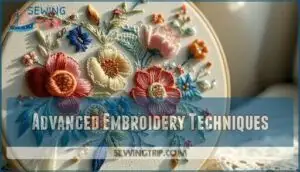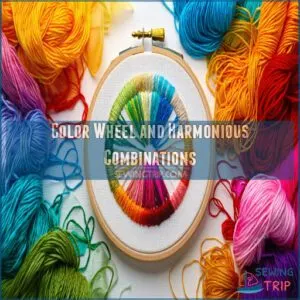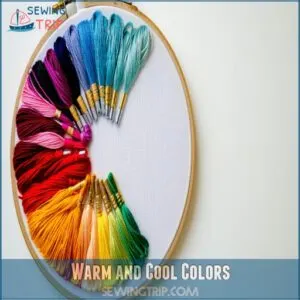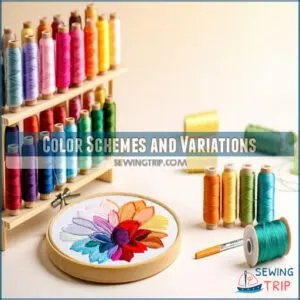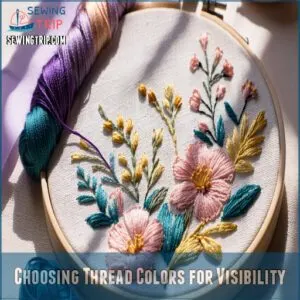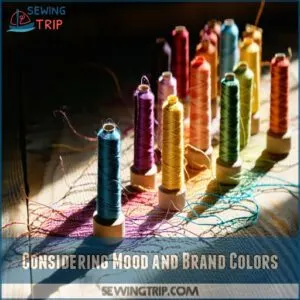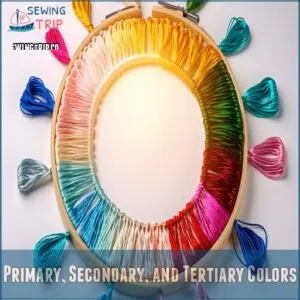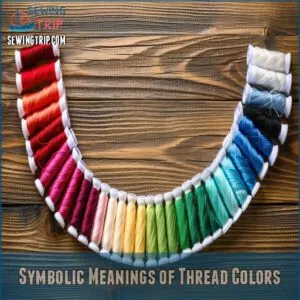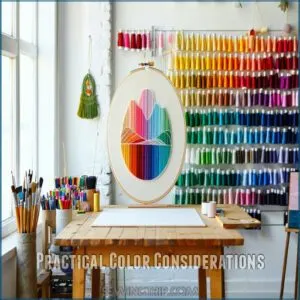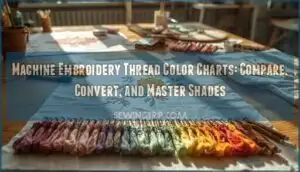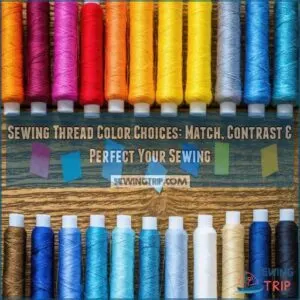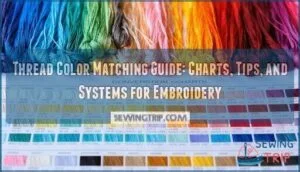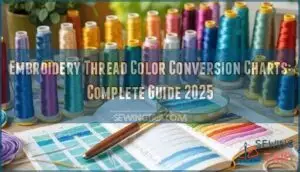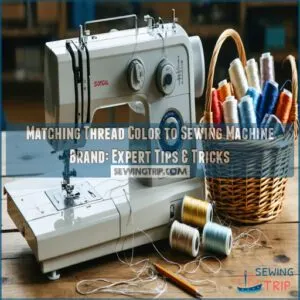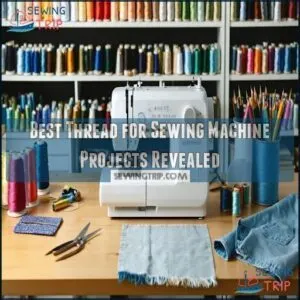This site is supported by our readers. We may earn a commission, at no cost to you, if you purchase through links.
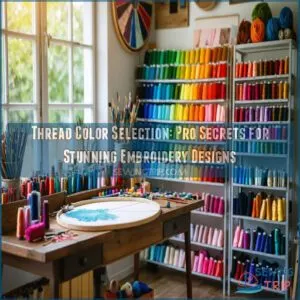 Choosing thread colors for embroidery designs isn’t just about picking pretty hues—it’s an art form that can make or break your masterpiece.
Choosing thread colors for embroidery designs isn’t just about picking pretty hues—it’s an art form that can make or break your masterpiece.
You’ll want to play with color wheels, experiment with contrasts, and understand how different threads interact.
Start with classic primaries like red, blue, and yellow, then branch out to metallics or neon for extra pizzazz.
Mix neutrals with bold accents to create visual harmony, and don’t be afraid to break traditional rules.
Whether you’re going for professional polish or eye-catching drama, thread color selection lets you transform ordinary fabric into a canvas of personal expression.
Ready to discover your inner color maestro?
Table Of Contents
Key Takeaways
- You’ll unlock stunning embroidery designs by mastering the color wheel and understanding how different hues interact, using complementary and analogous color schemes to create visual harmony.
- Your thread color choices aren’t just aesthetic—they’re a powerful communication tool that conveys mood, brand identity, and emotional storytelling through strategic color psychology.
- Don’t just pick colors blindly; test your thread selections by checking visibility, contrast, and how they look under different lighting conditions on your specific fabric background.
- You’ve got a world of thread options beyond basic colors—from metallic and neon threads to specialized techniques like 3D embroidery—that can transform your designs from ordinary to extraordinary artistic statements.
Thread Color Options
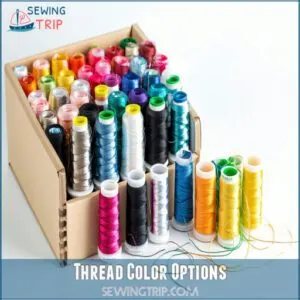
You’ll be amazed at the spectrum of thread colors waiting to transform your embroidery designs from ordinary to extraordinary.
From classic whites and blacks to flashy metallics and neon threads, you’ve got a rainbow of options that’ll help you create eye-catching, professional-looking embroidery that’ll make your projects pop.
Standard Thread Colors
When diving into embroidery, standard thread colors are your artistic foundation.
You’ll want to master:
- Primary color mastery (red, blue, yellow)
- Secondary color blending (green, orange, purple)
- Classic neutral tones (white, black, gray)
Choosing the right thread color isn’t just about aesthetics—it’s about colorfastness, thread sheen, and creating visual harmony that speaks volumes without saying a word.
Understanding color wheel usage is essential for selecting threads that complement each other and create stunning embroidery designs, which showcases the importance of visual harmony and embroidery designs.
Specialized Thread Colors
Want to level up your embroidery game? Specialized threads like metallic threads, neon options, and holographic finishes are your secret weapon.
From iridescent colors that shimmer to glow-in-the-dark threads that pop, these unique embroidery thread colors transform ordinary designs into extraordinary statements.
They’re not just threads—they’re your creative passport to jaw-dropping artwork that stops people in their tracks. Mastering metallic embroidery techniques can elevate your designs and make them truly unforgettable.
Custom Thread Colors
After exploring specialized threads, you’re ready to discover the magic of custom thread colors.
Embroidery isn’t just about following rules—it’s about breaking them creatively.
Your color palette becomes a personal playground of expression.
- Mix and match unique hue combinations
- Experiment with thread dyeing techniques
- Create signature shades that pop
Master custom thread colors and transform ordinary designs into extraordinary art.
Color Charts and High-Contrast Colors
Discover the power of color charts with a strategic approach to thread color selection.
Your embroidery’s visual hierarchy depends on mastering high-contrast colors and precise color matching.
DMC color cards become your secret weapon, offering thread samples that bring color harmony to life.
For a detailed guide to thread colors, explore this helpful embroidery thread color chart.
With the right palette creation techniques, you’ll transform ordinary designs into stunning masterpieces that pop.
Advanced Embroidery Techniques
When you’re ready to transform your embroidery from basic to extraordinary, advanced techniques will be your secret weapon.
You’ll discover stunning 3-D effects, explore decorative elements like crystals and specialized stitches, and create custom designs that’ll make your work stand out from the crowd with extraordinary results.
3. D Embroidery and Thicker Threads
Strategically using thick threads can transform your embroidery from flat to phenomenal.
These powerful thread options elevate your designs with dimensional flair:
- Choose 30-weight threads for bold, raised textures
- Experiment with foam-based embroidery techniques
- Select wool and acrylic blends for luxurious depth
- Adjust machine settings to accommodate thicker threads
Mastering thick thread embroidery means understanding tension, needle size, and creative potential for truly stunning textured designs.
Decorative Elements and Customization
Texture transforms embroidery from simple stitching to wearable art.
Add crystal embellishments, metal badges, or custom patches to elevate your design’s wow factor.
Experiment with fabric painting techniques and laser cutting to create unique dimensional elements.
Your thread color palette becomes a canvas for creativity, turning ordinary embroidery into extraordinary personal statements that pop with visual excitement.
Specialized Stitches and Patch Designs
Ready to level up your embroidery game? After playing with decorative crystals, you’ll want to master specialized stitches that transform ordinary patches into extraordinary art.
Check out these pro techniques:
- Layered stitch variations
- Textural thread blending
- Dimensional embroidery methods
- Custom patch edge techniques
- Innovative fabric manipulation
These stitch secrets will help you craft unique embellishments that pop with personality and professional flair.
Color Theory Basics
Master the art of thread color selection by understanding the color wheel’s magic and how different hues interact.
You’ll learn to create jaw-dropping embroidery designs that pop with harmonious color combinations that’ll make your artwork sing, utilizing the knowledge of how different hues interact to produce jaw-dropping effects.
Color Wheel and Harmonious Combinations
After exploring 3-D embroidery techniques, let’s zoom in on the color wheel—your secret weapon for thread color magic.
Color harmony isn’t rocket science; it’s about understanding how hues dance together.
Complementary colors pop, while analogous shades sing in unison.
Your thread color selection gets a supercharge when you map out these harmonious combinations, transforming good designs into jaw-dropping masterpieces with the help of thread color magic.
Warm and Cool Colors
Diving into color temperature, warm and cool colors are your secret weapons in thread color selection.
The color wheel isn’t just a pretty circle—it’s your roadmap to design mastery.
- Warm colors spark energy and passion
- Cool colors whisper calm and sophistication
- Neutral hues bridge dramatic color shifts
- Vibrant contrasts create visual excitement
Master these color temperatures to transform your embroidery from good to breathtaking.
Color Schemes and Variations
Imagine your embroidery thread as a color symphony, where every hue plays a unique role in creating visual harmony.
Color schemes are your secret weapon for stunning designs, transforming simple stitches into mesmerizing artwork, from monochromatic elegance to complementary contrast.
Understanding tint shades and hue variations lets you orchestrate gradient effects that’ll make your embroidery sing.
To achieve professional results, utilizing thread color charts is essential for selecting the perfect thread colors and ensuring color accuracy in your embroidery projects.
Thread Color Selection Tips
When selecting thread colors for your embroidery design, you’ll want to master the art of visibility, mood, and brand representation.
Your color choices can transform a simple stitch into a stunning visual statement that speaks volumes about your creative vision.
Choosing Thread Colors for Visibility
After dancing through color theory, it’s time to make your embroidery pop.
Thread contrast is your secret weapon for visibility.
Match your thread color to your fabric’s texture and light reflection.
Run visibility tests: hold your design in different lights, check color saturation, and make certain your design stands out.
Your threads should speak loud and clear without shouting, using thread contrast to ensure your message is conveyed effectively.
Considering Mood and Brand Colors
After dialing in thread visibility, let’s tap into the emotional power of color for your embroidery projects.
Mood boards aren’t just pretty—they’re your secret weapon for nailing brand identity and emotional connections.
- Color psychology transforms threads from mere lines to storytelling tools
- Your chosen hues speak volumes about your design’s personality
- Branding colors can make or break your visual hierarchy
Thread selection is an art of strategic emotional expression.
Effective embroidery also relies on understanding thread color systems to guarantee consistency and accuracy in the final product.
Primary, Secondary, and Tertiary Colors
Want to master color harmony like a pro? Understanding primary, secondary, and tertiary colors is your secret weapon in embroidery design.
These color categories form the backbone of your creative palette, offering endless possibilities for hue variation and tint effects.
| Color Type | Description | Embroidery Impact |
|---|---|---|
| Primary | Red, Blue, Yellow | Foundation colors |
| Secondary | Orange, Green, Purple | Blend from primaries |
| Tertiary | Yellow-Orange, Red-Orange | Complex color nuances |
| Shade | Darker variations | Depth and dimension |
| Saturation | Color intensity | Visual vibrancy |
The table outlines the different color types, including their descriptions and embroidery impacts, providing a comprehensive guide to understanding and applying colors effectively in embroidery design.
Symbolic Meanings of Thread Colors
After exploring primary and secondary colors, let’s discover the power of thread color symbolism.
Each hue carries deep emotional and cultural significance.
Red sparks passion and courage, while blue whispers trust and calm.
White symbolizes purity, black exudes sophistication, and green represents growth.
Your thread color isn’t just a visual choice—it’s a silent storyteller that speaks volumes about your design’s mood and message.
Practical Color Considerations
When selecting thread colors for your embroidery, you’ll want to master the art of color matching and balancing to create eye-catching designs that pop off the fabric.
Understanding how to preview colors, avoid common pitfalls, and work with digitization techniques will transform your embroidery from good to truly professional.
DMC Thread and Digitization
When you’ve nailed color selection tips, digitizing takes your embroidery game to the next level.
With the right digitization tools, you’ll discover thread conversion magic, bringing your creative vision to life with pixel-perfect accuracy.
Utilizing a DMC thread digitizer is essential for achieving professional embroidery results.
DMC’s embroidery digitizer transforms your designs into machine-ready files, converting graphics into precise stitch instructions.
Color Matching and Balancing
The art of color matching demands precision and a keen eye for thread harmony.
Mastering color balancing transforms good embroidery into breathtaking designs that sing with visual impact.
- Feel the thrill of perfect color synchronization
- Conquer the complexity of shade selection
- Discover your creative color potential
- Eliminate design guesswork forever
- Elevate your embroidery to professional brilliance
Blend your threads with confidence, adjusting hue and saturation to create stunning, cohesive compositions that captivate and inspire.
Previewing Thread Colors on Fabric
After matching colors precisely, grab those fabric scraps and test your thread color magic.
Digital previews are handy, but nothing beats laying actual thread swatches directly on your project fabric.
Pro tip: Check colors under different lighting conditions – what looks perfect in your studio might surprise you elsewhere.
Trust your thread color chart, but trust your eyes more.
Common Pitfalls in Thread Color Selection
Ever wondered why your embroidery design falls flat?
Dodge these thread color selection landmines with pro precision:
- Color Overload: Avoid overwhelming visual chaos
- Thread Clashing: Prevent jarring color combinations
- Tint Mistakes: Watch subtle shade shifts
- Hue Confusion: Understand color temperature relationships
To achieve harmonious embroidery, understanding thread color choices is vital for selecting the perfect thread.
Master your embroidery thread color chart, and transform potential pitfalls into stunning, harmonious designs that sing with sophistication.
Frequently Asked Questions (FAQs)
How do I choose the right thread color for my embroidery designs?
Pick colors that pop against your fabric, tell your design’s story, and reflect your mood.
Consider contrast, fabric background, and the emotional impact of your chosen thread hues for stunning embroidery results.
How much do embroidery thread color charts cost?
When money talks, embroidery thread color charts range from free digital downloads to $50 physical sets.
You’ll find budget-friendly options online, with DMC and craft stores offering affordable resources to fuel your creative passion.
What is embroidery thread conversion?
You’ll convert thread colors across different brands when their exact shades aren’t available.
It’s like translating color languages, helping you swap out threads while maintaining your design’s original color vision and aesthetic.
What is a polyester thread color chart?
When color confusion strikes like a bad fashion nightmare, polyester thread color charts become your trusty sidekick.
They’re your visual roadmap, helping you navigate through hundreds of shades with laser-precision and zero guesswork.
What type of embroidery thread is best?
DMC embroidery thread stands out as the top choice.
Its six-strand design offers versatility, consistent quality, and a vast color range.
You’ll love its durability and ease of use for both beginners and professional stitchers.
How to choose thread colors for embroidery?
You’ll nail your embroidery by matching thread colors to your fabric’s vibe, considering design mood, contrast, and using the color wheel.
Test swatches first to see how hues dance together before committing.
What is the best color for embroidery?
Like a painter choosing the perfect stroke, your best embroidery color depends on your design’s mood, fabric background, and purpose.
Experiment with contrast, harmony, and emotion to make your stitches truly sing.
How do I choose a color palette for embroidery?
You’ll want to explore the color wheel, pick a scheme that speaks to your design’s mood.
This process involves testing color combinations on fabric scraps, which is crucial for achieving the desired look.
Experiment boldly, but keep harmony and contrast in mind for a stunning embroidery piece.
What color is 333 embroidery thread?
In the quiet world of embroidery threads, DMC 333 whispers a deep, rich olive green.
You’ll find this earthy shade perfect for nature-inspired designs, landscapes, and adding depth to your needlework’s visual texture.
How do I prevent thread colors from bleeding?
Wash your embroidery in cold water with a color-catching sheet.
Add a pinch of salt to the first wash, use gentle detergent, and test colorfastness on a small sample before cleaning the entire piece.
Conclusion
Ultimately, thread color selection for embroidery designs is your creative passport to transforming ordinary fabric into extraordinary art.
You’ve learned the secrets: play with color wheels, understand contrast, and trust your artistic instincts.
Whether you’re crafting professional pieces or experimenting with bold statements, your thread choices tell a unique story.
Embrace the journey, break traditional rules, and let your embroidery designs speak volumes through vibrant, thoughtful color selections.
- https://colmanandcompany.com/blog/2013/04/choosing-embroidery-thread-colors/
- https://www.tatreezandtea.com/tatreezing/2020/1/05/choosing-thread-colors-for-your-embroidery
- https://www.stadriemblems.com/color_chart/
- https://www.showyourlogo.com/resources/embroidery-thread-color-chart/
- https://stitchpalettes.com/the-embroidery-thread-palette-generator/

